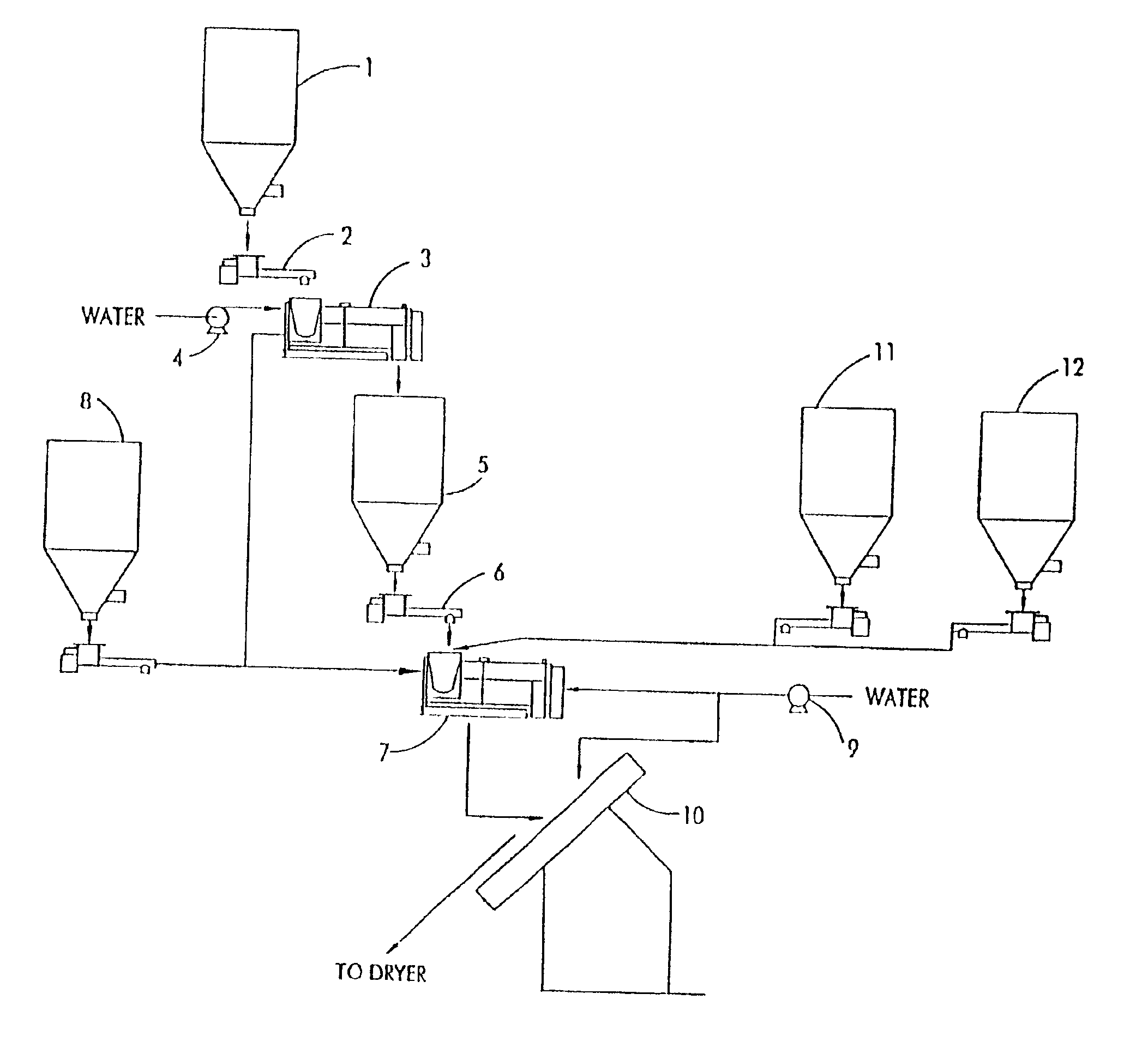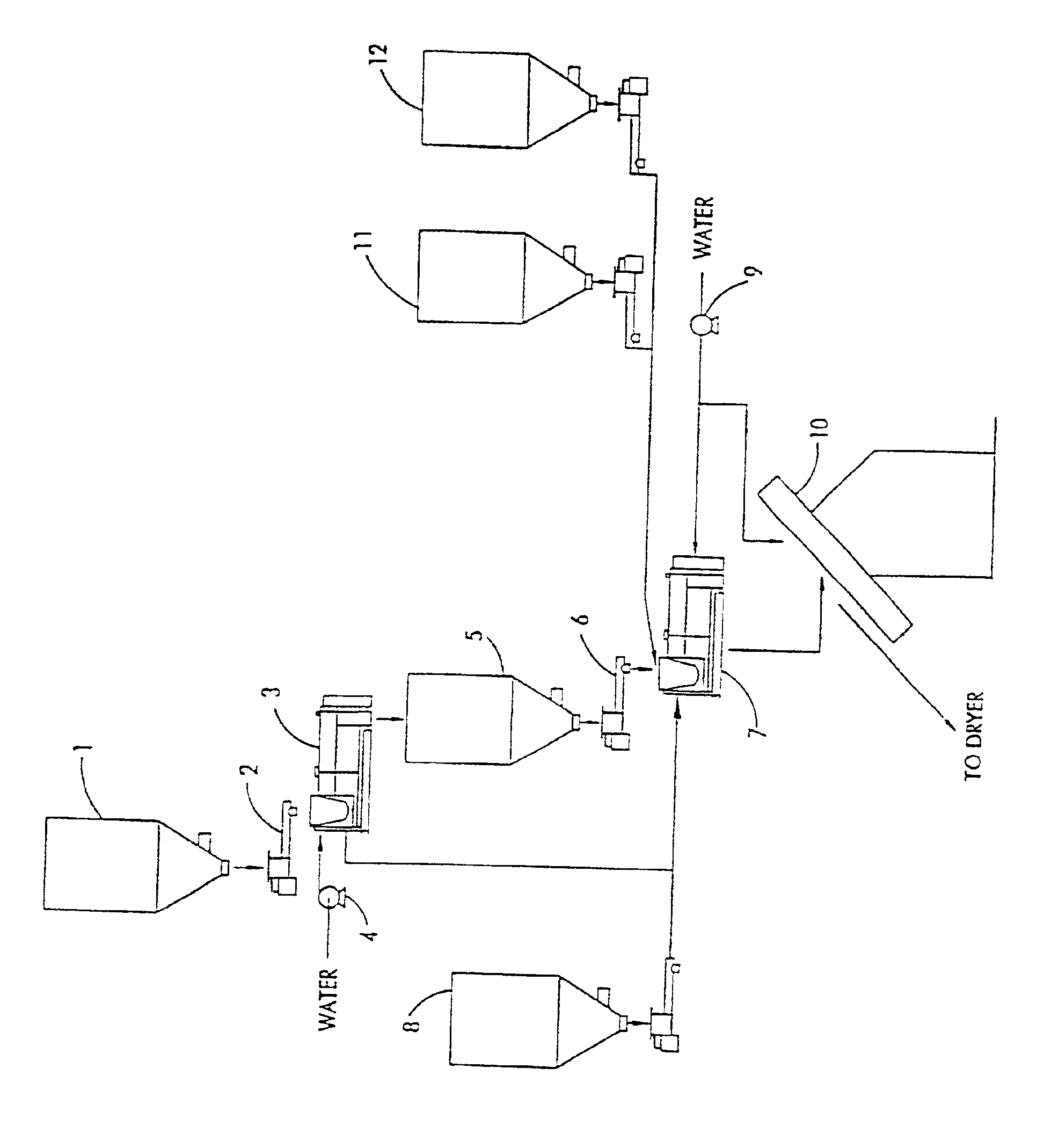Soil conditioning agglomerates containing calcium
a technology of soil conditioning agglomerates and calcium, which is applied in the direction of calcium fertilisers, granulation in rotating dishes/pans, ammonium orthophosphate fertilisers, etc., can solve the problems of easy loss of dust, difficult bulk-blending with other materials, and inability to carry dust, etc., to achieve sufficient mechanical strength and improve efficacy
- Summary
- Abstract
- Description
- Claims
- Application Information
AI Technical Summary
Benefits of technology
Problems solved by technology
Method used
Image
Examples
example 1
[0061]In this example, agglomerates were made from preagglomerate mixtures containing varying amounts of CaO combined with CaCO3, urea and / or potash fines along with an aqueous solution of NORLIG A brand calcium lignosulfonate (about 54 weight percent lignosulfonate salt) as a binder. The preagglomerates were formed by thoroughly mixing CaO with measured quantities of CaCO3, urea and / or potash fines. The CaO, CaCO3, urea and potash fines each exhibited a particle size of −100 mesh. Once formed, the preagglomerate was then hand fed to a shallow pan disc pelletizer and formed into agglomerates. In some trials, the aqueous solution of lignosulfonate binder was mixed with the other components of the preagglomerate before being introduced onto the pan, while in other trials the binder was added to the other materials after they were introduced onto the pan. It is preferred that the binder be thoroughly incorporated into the preagglomerate mixture prior to being introduced into the pan. D...
example 2
[0064]Three samples of cement kiln dust taken directly from the dust collection apparatus of a portland cement plant (Plant A) were hydrated using varying amounts of water. The three samples were combined in a high energy mixer with 10, 14 and 16 weight percent water, respectively and stored in sealed containers for approximately 24 hours. Each sample of hydrated material was then mixed with 7 weight percent potash, 5 weight percent of an aqueous solution of NORLIG A brand calcium lignosulfonate (about 54 weight percent lignosulfonate salt) and additional water in a high energy mixer to form a preagglomerate. The preagglomerate was then fed to a FERRO-TECH brand shallow pan disc pelletizer and formed into agglomerates. During pelletizing, approximately 5 weight percent of additional water was added to the forming agglomerates. The agglomerates had a size ranging from approximately −6 to +16 mesh. These agglomerates were then oven dried at 120° C. for approximately 24 hours. The drie...
example 3
[0065]Four samples of cement kiln dust were taken directly from the dust collection apparatus of each of two other portland cement plants (Plants C and L) and hydrated using varying amounts of water. The four samples from each plant were combined in a high energy mixture with 4, 6, 8 and 10 weight percent water, respectively, and stored in sealed containers for approximately 24 hours. Each of the samples of hydrated material was then mixed with 8 weight percent of an aqueous solution of NORLIG A brand calcium lignosulfonate (about 54 weight percent lignosulfonate salt) and additional water in a high energy mixer to produce a preagglomerate. The preagglomerate was then fed to a FERRO-TECH brand shallow pan disc pelletizer and formed into agglomerates. During pelletizing, approximately 2.5 to 5 weight percent of additional water was added to the forming agglomerates. The agglomerates had a size ranging from approximately −6 to +16 mesh. These agglomerates were then oven dried at 120° ...
PUM
| Property | Measurement | Unit |
|---|---|---|
| Percent by mass | aaaaa | aaaaa |
| Percent by mass | aaaaa | aaaaa |
| Percent by mass | aaaaa | aaaaa |
Abstract
Description
Claims
Application Information
 Login to View More
Login to View More - R&D
- Intellectual Property
- Life Sciences
- Materials
- Tech Scout
- Unparalleled Data Quality
- Higher Quality Content
- 60% Fewer Hallucinations
Browse by: Latest US Patents, China's latest patents, Technical Efficacy Thesaurus, Application Domain, Technology Topic, Popular Technical Reports.
© 2025 PatSnap. All rights reserved.Legal|Privacy policy|Modern Slavery Act Transparency Statement|Sitemap|About US| Contact US: help@patsnap.com


